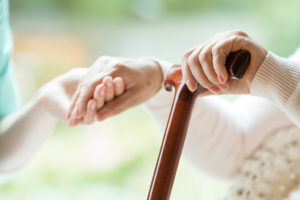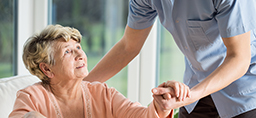
Laura Maclam is talking about older folks and falls, and she is getting pretty worked up.
“I want to scream it from every rooftop: Falling is absolutely not a natural part of aging,” she says.
She’s a woman on a mission, all right. And that mission is to keep seniors standing on solid ground. Even if she has to stand on a rooftop.
Maclam knows how devastating a fall can be, especially for an older person.
A former paramedic and Aero Med flight nurse, she has seen plenty of fall victims in her career.
But what got her revved up about the topic was not an individual victim—it was a number.
52%.
Maclam found that number when looking at Spectrum Health emergency department records to identify the most serious problems of adult trauma patients.
She was sure car accidents would be No. 1.
It was falls.
“Fifty-two percent of admitted adult trauma patients over 65 were secondary to a fall,” she said. “These are people with multi-system trauma.
“They might have a brain injury and a broken pelvis. They are the highest acuity, highest risk, sickest trauma patients.”
4 tips to stay strong
Laura Maclam suggests these actions to improve strength and flexibility in daily life:
- At the grocery store, take an extra lap or two around the store to increase the number of steps you take.
- When you have a counter or item available for balance, stand on one leg and count to 10. Switch and stand on the other leg.
- Do ankle pumps while sitting. Stretch the legs in front and flex the feet up and down. Add in ankle rolls and knee lifts.
- Get up from a chair without using the arm rests (assuming it is not on wheels). To do so, you will straighten the spine and work the core muscles.
Her first thought was: What are we doing wrong in West Michigan?
But then she looked at national figures. She found that 2.8 million Americans over the age of 65 went to an emergency room because of a fall. That’s an ER visit every 11 seconds.
“This is a national problem that is almost epidemic or pandemic at this point,” she said. “Clearly, we need to address this.”
She faces one major stumbling block—yes, bad pun—and that is passive resignation. Too many people see falls as an inevitable part of aging. It happens. What can you do about it?
Plenty, Maclam says.
First, recognize that falls are serious. As serious as a heart attack. Or a stroke. Or cancer.
“One fall could be devastating,” she said. “You could end up unable to live independently. The cost sometimes is enough to be catastrophic.”
And half of those who fall once will fall a second time.
The risk rises as people age because of health conditions, medication and inactivity.
“As we get older, we sit and become more immobile, which leads to deconditioning and increased risk of falling,” she said.
Because those changes sneak up on folks, many underestimate their fall risk.
Second, focus on prevention.
Researchers have honed in on 6 steps shown to reduce fall risk:
- Home modification. Get rid of slippery rugs. Declutter. Make sure you have good lighting. Keep the driveway clear. Fix steps that are cracked.
- Mobility and balance. Do physical activities every week that help keep you strong and balanced, like tai chi and aquatic exercises or fitness classes.
- Talk to your doctor. Do you take meds or have a condition that can make falls more likely? Has your vision, hearing or reflexes changed? What can you do to reduce fall risk?
- Get an annual eye exam.
- Wear solid footwear.
- Have your hearing checked. Your balance center is in your inner ear, so changes in hearing will affect balance—and hearing aids might improve it.
She hopes this message will reach family members of older adults, too. She urges them to raise the issue with loved ones, offer to take walks or do activities together, and help with home modifications.
“Grandma doesn’t need another Yankee candle,” she says. “She needs grab bars in the bathroom.”
 /a>
/a>
 /a>
/a>
 /a>
/a>
As a 76 year old lady I have personal experience with falls, fortunately with no lasting injuries. Grab bars and non slip mats are important but most important thing we can do is walk and move. Tai chi is a marvelous exercise for balance, and to make new friends,!
I’m having problems with my balance, would Tai chi help me?
Hi Richard, Tai chi is noted for strengthening muscles and improving flexibility. It is often recommended for balance improvement. Before embarking on a new exercise regimen, we’d suggest discussing your concerns with your provider as he/she may offer additional recommendations and advice. 🙂
I am a senior who just recovered from a bad fall. I never realized how badly one could get hurt from a fall. I was on warfarin and sustained a brain bleed, a cracked knee cap and cracked wrist. I tripped on my cane and fell flat on my face. Maybe we need some training on how to use a cane. I now use a walker.
Where in Grand Rapids can I find Tai Chi classes ?
Hi Jackie! Thanks for asking and for being a Health Beat reader. A Google search brings up several options in the Grand Rapids area – https://www.google.com/search?q=tai+chi+classes+near+me&rlz=1C1GCEB_enUS848US848&oq=Tai+chi+classes+near+me&aqs=chrome.0.0l8.7480j0j4&sourceid=chrome&ie=UTF-8. Hope this helps.
Enjoy! 🙂
Consider looking into Senior Neighbors, they have a wellness program and offer an online Tia Chi zoom class https://seniorneighbors.org/services/healthy-aging/